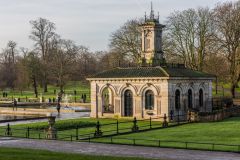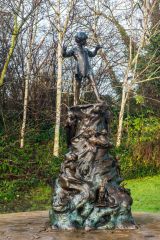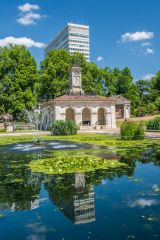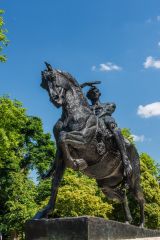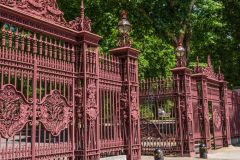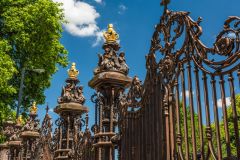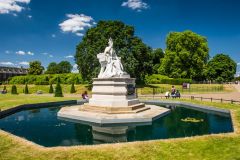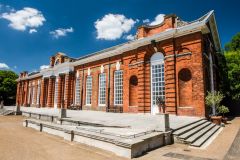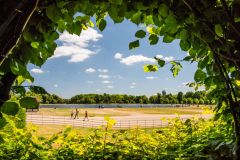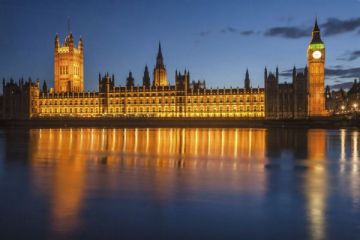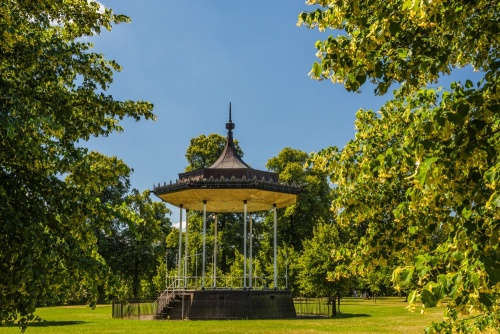
Kensington Gardens is one of eight royal parks in London. It was originally part of neighbouring Hyde Park but is now a completely separate public park with a character all its own. At the park's western end stands the royal home of Kensington Palace while at the eastern end The Serpentine separates Kensington Park from Hyde Park.
History
The park we now know as Kensington Gardens began as part of Hyde Park, laid out by Henry VIII as a deer chase, or hunting ground. That changed in 1689 when King William III and Queen Mary bought Nottingham House at the western edge of Hyde Park. The royal couple called in Sir Christopher Wren to transform the existing house into a royal residence renamed Kensington Palace.
Queen Mary created a formal garden area beside the Palace, defined by box hedges. The garden was designed in Dutch style to make her husband William, Prince of Orange, feel at home. When Mary's sister Anne took the throne in 1702 she separated 30 acres of land from Hyde Park and asked the garden designers George London and Henry Wise to create a new garden in English style. Part of Queen Anne's new garden was the Orangery, north of the Palace.
The gardens really began to take shape in 1728 when Queen Caroline, King George II's consort, took another 300 acres from the western part of Hyde Park. She called in the landscape architect Charles Bridgeman to lay out a garden on a grand scale.
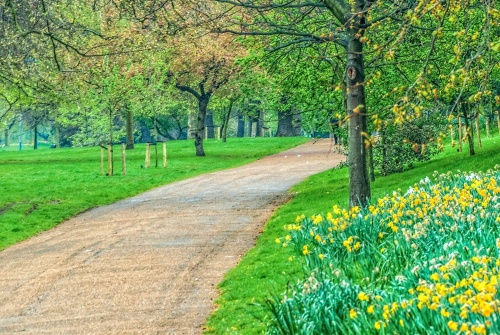
Bridgeman created Round Pond immediately east of the Palace, with avenues of trees radiating out from the pond like the spokes of a wheel. The avenues led a viewer's eye to focal points like the Queen's Temple dotted around the landscape.
Bridgeman dammed the Westbourne Stream to create Long Water and built a ditch separating Kensington Garden from Hyde Park. The ditch became known as a ha-ha, possibly because it took visitors by surprise. The ha-ha created the illusion of continuos parkland rather than a separate private park (Kensington Gardens) and a public park (Hyde Park). The effect was copied widely and soon ha-has were a regular feature in country house landscape gardens.
Kensington Gardens were very much the royal family's private gardens, but they opened the gates each Sunday to 'respectably dressed' visitors. The main feature of the new garden was Broad Walk, running past the front facade of the Palace, and Broad Walk became THE fashionable place in London to see and be seen.
All that changed in 1837 when Queen Victoria moved her official residence to Buckingham Palace. The garden was left to decay and most of the ha-ha was filled in and West Carriage Drive became the boundary between Kensington Gardens and Hyde Park.
The gardens were open to the public in 1841 and became one of London's favourite public parks.
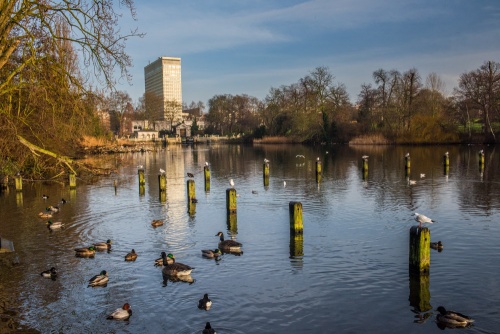
What to See
Kensington Palace
At the extreme western edge of the park stands Kensington Palace, built by Sir Christopher Wren for King William and Queen Mary. Wren's mandate was to build something quickly and cheaply, so the royal residence was made from red bricks rather than stone. And it was built quickly; it opened in just six months and the royal couple moved in on Christmas Eve 1689. Queen Victoria grew up here, and Diana, Princess of Wales was a later resident.
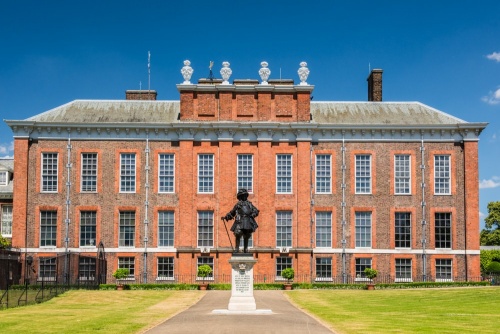
William III Statue
Outside the south facade of Kensington Palace stands a larger-than-life bronze statue of King William III (1650-1702). The statue is a reminder that William III made his home at Kensington Palace, hoping that it would help his asthma to be further away from the River Thames.
The statue was designed by Heinrich Bauke while the base was created by Sir Aston Webb, who also designed the gilded statue of Queen Victoria in front of Buckingham Palace. The statue was given to King Edward VII by his nephew, the German Kaiser Wilhelm II.
The statue's plinth is inscribed with these words, 'William III of Orange, King of Great Britain and Ireland presented by William II, German Emperor and King of Prussia to King Edward VII for the British Nation. 1907.'
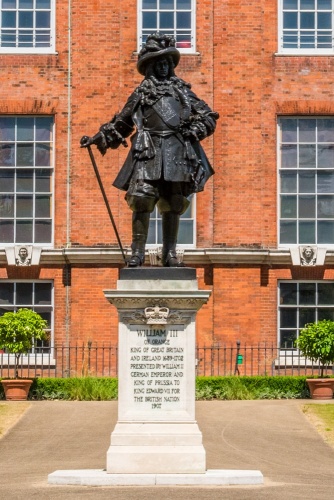
Queen Victoria Statue
At the edge of Broad Walk, just east of Kensington Palace, is a marble statue of a youthful Queen Victoria holding a sceptre. The statue was designed in 1893 by Victoria's daughter Princess Louise, the Duchess of Argyll and depicts the queen as she appeared at her coronation in 1837.
Queen Victoria spent her childhood at Kensington Palace and was erected by the Kensington Golden Jubilee Memorial Executive Committee to mark the queen's Golden Jubilee.
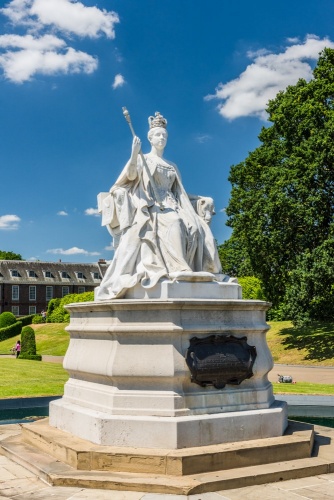
Elfin Oak
One of Kensington Gardens' most popular features is this sculpture made from the trunk of a hollow oak tree. The tree trunk is decorated with small figures of animals, elves, and fairies. The sculpture was created by Ivor Innes in 1930 and was given by Lady Fortescue. The tree trunk comes from Richmond Park.
The tree featured in the inside cover art for Pink Floyd's 1969 album Ummagumma. It was restored in 1996 after a campaign led by comedian Spike Milligan. It is now protected by a metal cage.
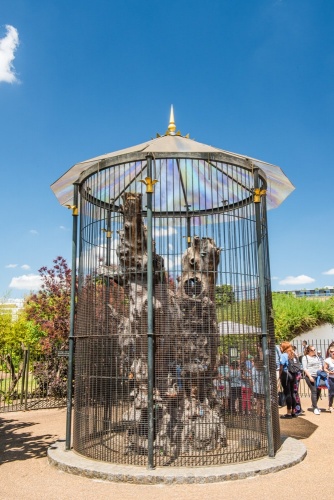
Long Water
This elongated lake runs south from the Italian Gardens and then turns east to become The Serpentine as it flows into Hyde Park. Long Water and The Serpentine were created when Charles Bridgeman dammed the Westbourne Stream under the direction of Queen Caroline.
Serpentine Bridge
This elegant bridge, erected in 1820 by the engineer John Rennie, carries West Carriage Drive over the junction of The Serpentine and Long Water and marks the boundary between the two parks.
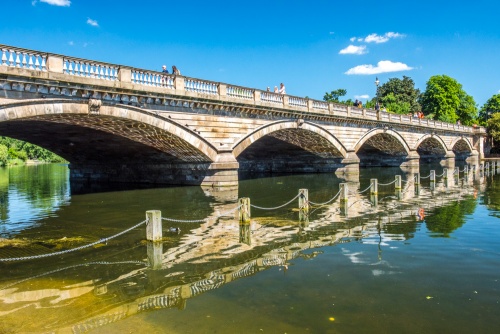
Serpentine Galleries
There are two public art galleries within the park. Near the Serpentine Bridge is the Serpentine Sackler Gallery, occupying an 1805 gunpowder magazine. Across Long Water stands the original Serpentine Gallery, opened in 1970. In the forecourt to the Gallery is a memorial to Diana, Princess of Wales, who served as a Serpentine Gallery patron. It takes the form of eight stone benches surrounding stone plaques including one in the shape of a tree.
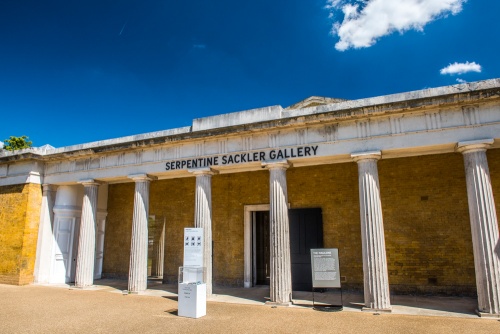
Albert Memorial
On the southern boundary of the park looking across to the Royal Albert Hall stands the Albert Memorial, Queen Victoria's monument to her consort, Prince Albert, who died in 1861 of typhoid. The grieving queen called upon the architect Sir George Gilbert Scott to create a striking memorial loosely modelled on the Eleanor Crosses erected by another grieving monarch five centuries earlier. The result is an exquisite example of Victorian Gothic architecture.
But it isn't called the Albert Memorial.
In fact, its official name is the Prince Consort National Memorial, but that doesn't stop everyone from native Londoners to foreign visitors from calling it the Albert Memorial!
A gilded figure of the Prince Consort sits within an ornately carved canopy. He holds a catalogue for the Great Exhibition of 1851, which he championed. Bronze statues of angels cling to the top of the memorial while marble sculptures representing the continents of Europe, Asia, America, and Africa stand at the corners. Around the monument's base runs a frieze depicting famous artists, sculptors, musicians, architects, and poets, a reminder of Prince Albert's support for the arts.
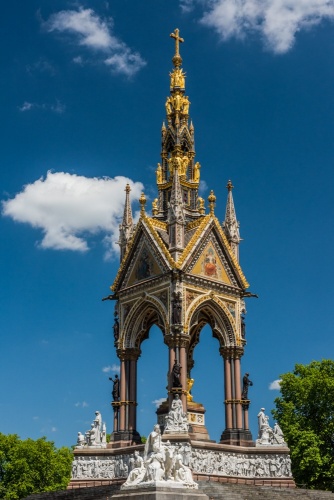
Peter Pan Statue
Immediately west of Long Water stands a statue of JM Barrie's magical character Peter Pan, the boy who wouldn't grow up. The location is no accident, for it is here on the shore of Long Water that Peter lands his birdnest boat in the story 'The Little White Bird'.
Barrie loved Kensington Gardens and was inspired by the setting. He lived locally and walked frequently through the park. He personally commissioned the sculptor Sir George Frampton to create a statue of Peter Pan, which was erected here in 1912. It shows Peter blowing a pipe, surrounded by rabbits, mice, squirrels, and fairies.
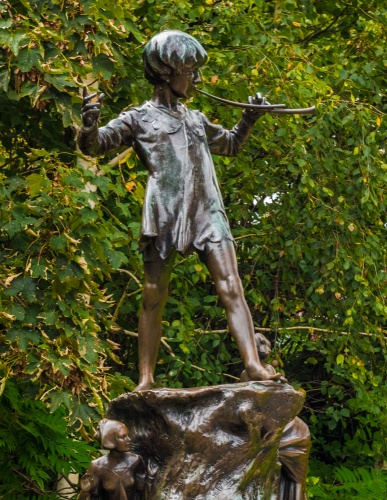
Italian Gardens
One of the most popular areas of the park is an Italianate water garden on the northern edge of the park near Lancaster Gate. The Grade II listed gardens were a gift from Prince Albert to Queen Victoria. It is modelled after the royal couple's gardens at Osborne House on the Isle of Wight.
The garden is based around four pools with central floral sculptures of Carrara marble. Dotted around the garden are statues and neoclassical urns.
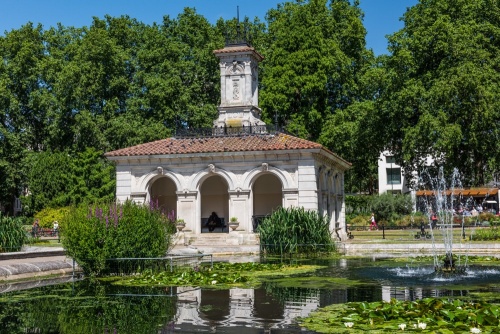
Edward Jenner Statue
On the east side of the Italian Garden is a memorial to Edward Jenner, who pioneered the use of vaccines to eradicate smallpox. The statue originally stood in Trafalgar Square but was moved to Kensington Gardens in 1862 after objections from anti-vaccinationists.
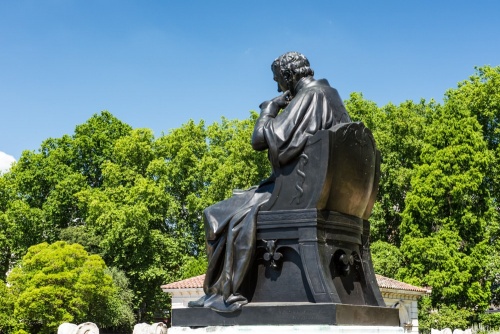
Queen Anne's Alcove
A stone's throw from the Italian Garden and immediately behind Lancaster Gate stands Queen Anne's Alcove, a neoclassical portico and niche designed in 1705 by Sir Christopher Wren. The Alcove originally stood on Dial Walk, in the formal garden south of Kensington Palace.
Just under the gable you can see Queen Anne's royal coat of arms. The Alcove was moved to its location beside Lancaster Gate in 1867 at the expense of a London builder named Cowley because it was thought to be ugly and attract 'undesirable persons'. It was used for a time as a storeroom for the park's gardeners.
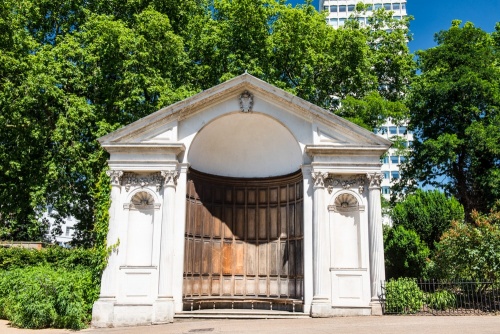
The Arch
On the north bank of Long Water stands a striking six-metre high sculpture by Henry Moore entitled The Arch. It was given by Moore as a gift to the nation in 1980. The sculpture takes the form of an arch made from seven blocks of Italian travertine weighing a combined 37 tonnes. The sculpture had to be disassembled in 1996 due to structural instability issues but was restored and re-erected in its original spot in 2012.
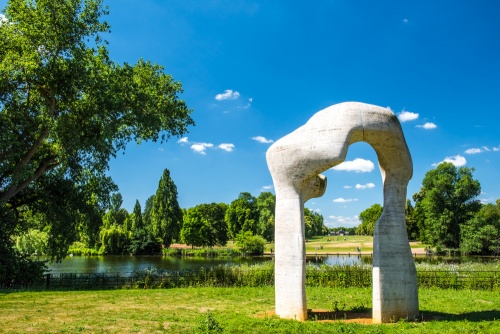
Coalbrookdale Gates
These formal cast-iron gates stand at the southern end of West Carriage Drive, just north of Kensington Gore. They were made by the Coalbrookdale Company and designed by Charles Crookes for the Great Exhibition of 1851, which was held in Hyde Park. They were moved here in 1871 while the neighbouring Albert Memorial was being built.
Each gate has a gilded finial of a crown, representing peace, while the stone pillars at each side of the gates are topped with stags' head vases, a reminder of the park's origins as a deer park.
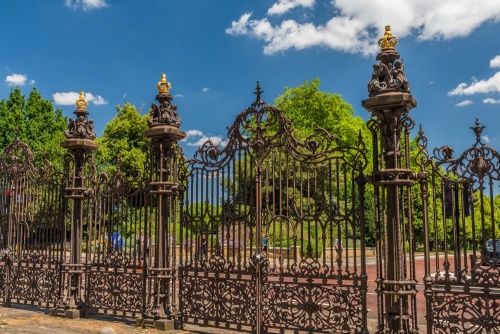
Queen Caroline's Temple
East of Lancaster Walk and Long Water stands a neoclassical summerhouse designed for Queen Caroline in 1734. The design is thought to be by William Kent, one of the most famous landscape architects of 18th-century England.
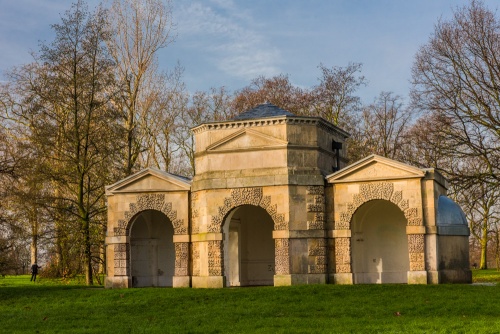
The summerhouse was once used as the park keeper's residence but has since been converted back into its original state. It takes the form of two large alcoves flanking an even larger central alcove.
Kensington Gardens Bandstand
Just south of the Round Pond stands a bandstand in Regency style erected in 1931. It replaced an earlier bandstand installed in 1869 near West Carriage Drive. That bandstand was moved to Hyde Park in 1886. The bandstand is unusual in that it has an ogee-shaped roof, which is said to provide better acoustics.
Queen Victoria granted permission for music to be performed in Kensington Gardens in 1855, but her decision was met with an unexpected backlash from the Archbishop of Canterbury, who complained that music in the park would be 'unseemly'.
He was supported by Colonel The Honourable Sir Charles Beaumont Phipps KCB, the Keeper of the Privy Purse (the official responsible for the financial management of the Royal Household) who sniffed that the working classes could manage without band concerts.
Victoria backed down and rescinded permission in 1856. Thankfully, attitudes have changed since then and there are regular band performances in the park.
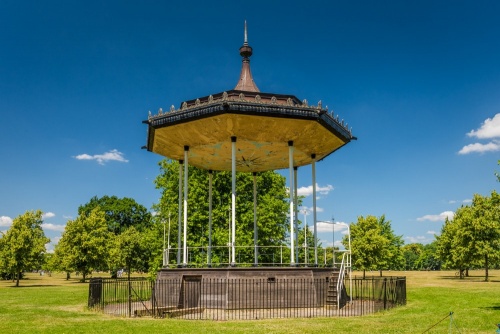
Physical Energy Statue
At a junction of paths on Lancaster Walk stands a striking bronze equestrian statue by George Frederic Watts (1817-1904) known as Physical Energy. The statue is an allegory for humanity's need to face new challenges and constantly seek new horizons. Watts worked on the statue for 20 years, from 1883 until his death in 1904.
The artist lived in Kensington for many years, and after his death his wife and friends had the statue cast in bronze and erected here as a memorial to the sculptor.
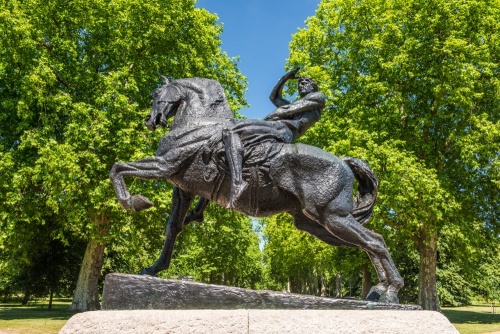
Speke Monument
Near the north end of Lancaster Walk is a granite obelisk in memory of the explorer John Hanning Speke, who is credited with discovering Lake Victoria. Speke also led several expeditions in search of the source of the Nile. The monument was designed by Philip Hardwick, the architect responsible for Euston Rail Station. It was erected in 1866 and paid for by public subscription.
Speke died mysteriously the day before he was to engage in a debate with fellow explorer Sir Richard Burton at the Royal Geographical Society about the source of the River Nile. Speke claimed that the river originated at Rippon Falls, a claim that was later proved to be correct.
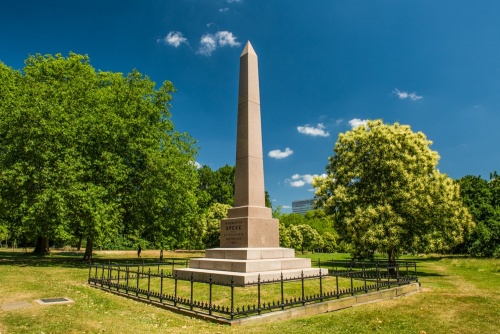
One of the least historic features in Kensington Gardens is also one of its most popular; the Diana, Princess of Wales' Memorial Playground was opened in 2000 in memory of the princess. The playground is within sight of her former home of Kensington Palace and is centred on a large wooden pirate ship.
Frequently asked Questions
Are Kensington Gardens open to the Public?
Yes. The gardens are open from 6 am until dusk daily.
Are Kensington Gardens part of Hyde Park?
No, though the parks are continuous (ie. you can freely walk between them so that it can be difficult to know exactly where one starts and the other ends.
Is Kensington Palace open to the public?
Yes. The King's State Apartments, Queen's State Apartments and the Gardens are open to visitors. There is a charge to visit.
Getting There
The nearest underground stations to Kensington Gardens are:
- Lancaster Gate & Queensway (Central Line)
- Bayswater (District Line)
- High Street Kensington (Circle and District Lines)
About Kensington Gardens
Address: Kensington Road,
London,
Greater London,
England, W2 2UH
Attraction Type: Park
Location: Between Bayswater Road in the north and Kensington Road in the south, immediately west of Hyde Park. The nearest underground stations are Lancaster Gate, Queensway, Bayswater, and High Street Kensington.
Website: Kensington Gardens
Royal Parks
Location
map
OS: TQ263801
Photo Credit: David Ross and Britain Express
Nearest station: ![]() Queensway - 0.4 miles (straight line) - Zone: 1
Queensway - 0.4 miles (straight line) - Zone: 1
HERITAGE
 We've 'tagged' this attraction information to help you find related historic attractions and learn more about major time periods mentioned.
We've 'tagged' this attraction information to help you find related historic attractions and learn more about major time periods mentioned.
Find other attractions tagged with:
Queen Victoria (Person) -
NEARBY HISTORIC ATTRACTIONS
Heritage Rated from 1- 5 (low to exceptional) on historic interest
Albert Memorial - 0.3 miles (Historic Building) ![]()
Kensington Palace - 0.3 miles (Historic House) ![]()
23-24 Leinster Gardens - 0.4 miles (Historic Building) ![]()
Science Museum - 0.7 miles (Museum) ![]()
Clockmakers' Museum - 0.7 miles (Museum) ![]()
Hyde Park - 0.7 miles (Park) ![]()
Natural History Museum - 0.7 miles (Museum) ![]()
Victoria and Albert Museum - 0.8 miles (Museum) ![]()
Nearest Holiday Cottages to Kensington Gardens:
Leaves Green, Greater London
Sleeps: 6
Stay from: £871 - 3614
Holmbury St Mary, Surrey
Sleeps: 9
Stay from: £842 - 4619
More self catering near Kensington Gardens
